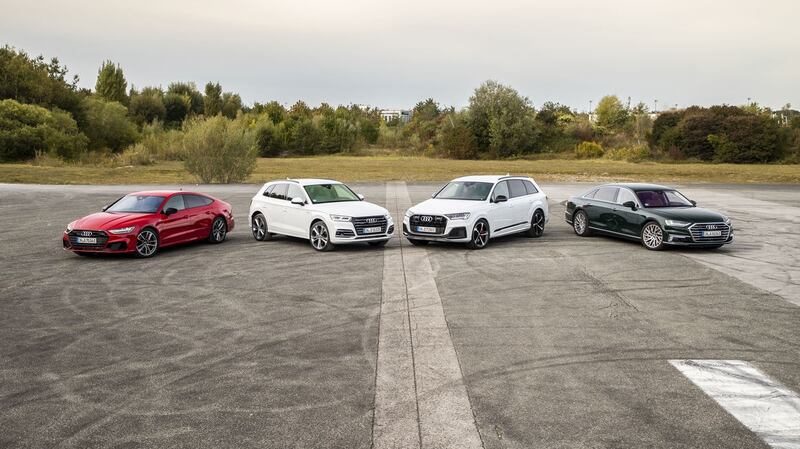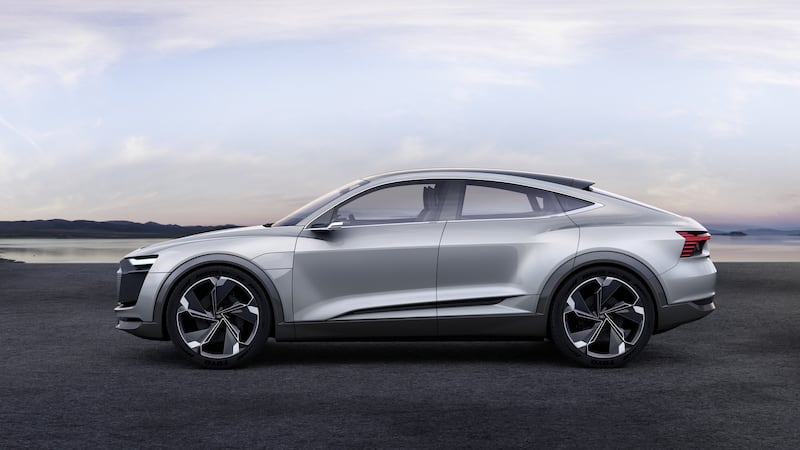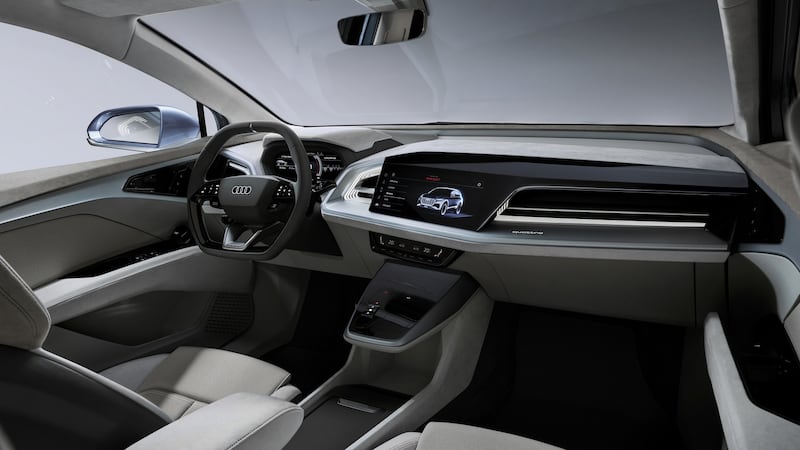Audi has unveiled its roadmap for an electric future, delivering 30 new electrified models to its range by 2025, 20 of which will be all-electric models. Of most interest to Irish motorists right now, however, will be the arrival in the coming months of a plug-in hybrid version of the popular Q5 with prices starting at €57,500, when grants are taken into account. The recently revamped Q5 has proved a big hit for the brand in Ireland so expect a bun fight for this version, which can run on electric-only for up to 40km before reverting to a regular hybrid format.
Plug-in hybrids
That promise of a 40km range stands up to scrutiny as well. We tested it over a mixed route in Bavaria that included unrestricted motorway, town driving and country roads, and even hitting motorway speeds of 140km at stages, it stayed in electric mode. Only when we pressed the accelerator to the floor for maximum acceleration did the 2-litre petrol engine kick in to boost the battery power. The end result was that over a route of 35.2km, we achieved a fuel economy figure of 0.2 l/100km and the car’s computer said there was still 4km of full electric power left in the battery. Just to put some old-school perspective on that fuel economy, it’s 1,412 mpg. As for emissions, the Q5 comes in at a mere 53g/km, while the plug-in A7 Sportback registers just 48g/km.
The Q5 is fitted with a 14.1 kW battery pack, which means on a regular 7.5 kw charging point it will take two hours to go from empty to full, but on faster chargers, like the ESB’s 50kW units, that should take less than 15 minutes. As with regular hybrids, it also uses power recuperation to recharge the battery during deceleration.

Alongside these, the company has developed two predictive software programmes that takes into account the destination you set in the sat-nav, then studies the set route. It take into account gradients, speed limits and traffic conditions, along with the driver’s usual throttle and braking traits, to try and maximise the power recuperation for the battery.
The plug-in Q5 is just the first of a fleet of plug-in hybrid variants on the way. It will be followed by an A8, A7 and Q7 versions in the near future.
Full-electric
But there’s a lot more to the electric plan. First up will be lower powered version of the recently launched all-electric E-Tron crossover. Known as the “50” compared to the current “55” version, it will enter at a lower price point than the current car.
After this will be a coupe-SUV version of the car - known in Audi parlance as the Sportback - which is merely a body format change on the current car.

Alongside this will be the new E-Tron GT sports car, based on the recently launched Porsche Taycan. Entering production early next year, it's a low-set four-door coupe, that will deliver top-end performance and handling, but thanks to adjustments to the floorpan of the J1 platform it shares with the Taycan, offers a surprising amount of legroom and space in the rear seats.

Family crossover
Arguably of more significance to the wider Irish public will be the arrival of the new all-electric Q4 E-Tron crossover in early 2021. Shown in concept form at present, this new model measures in about the same size as the current Q3 but manages to offer the same interior space as the current Q5. With an electric motor on its rear and a 74kW battery pack between the wheels, the so-called MEB platform is the basis for all future small and mid-sized electric models from Audi. A smaller electric motor can also be added to the front axle to offer Quattro four-wheel drive if desired.
With the relative low centre of gravity due to the heaviest part of the car - the battery - located on the floor between the wheels - it means cornering and handling should be much-improved on even the sportier combustion-engined Audis on sale at present.

Range is estimated to be towards 400km, but the most striking feature of the new car is the interior space. With no need for a transmission tunnel or an engine up front, the shorter overhang over the front axle means maximum legroom both front and rear. Once more the cabin sets new standards in clean lines and styling. We are assured by engineers and designers that the concept is “very, very close” to the production plan.
If Audi can get the price right on this car, then this will be the model its Irish customers will be queueing up to buy.
Audi’s top-end electric models
So the current E-Tron is built on Audi’s MLB platform, the E-Tron sports car on the J1 platform shared with Porsche, and the MEB platform underpinning future small and medium electric cars, it’s left to a new platform tagged as PPE to form the basis for all its big luxury models like the future all-electric A8 and Q8.
Also built in conjunction with Porsche engineers, it features a 100kW battery pack, electric motors on front and rear axles, and promising a range in excess of 500km an hour. What’s more, with the 800 volt charging system - first introduced in the Porsche Taycan - it means much shorter recharging times.
Carbon footprint
Of course, all these efforts to electrify its range won’t clean up Audi entire carbon footprint, so the company is starting to clean up the emissions of its supply chain. By 2050 the company says the entire network, from sourcing of resources through to the recycling of the end of life vehicle will be carbon neutral. As part of this, by 2025 it aims to have reduced its CO2 emissions by 30 per cent compared to 2015 measures.
Across its 14 production facilities worldwide, seven are now set up to build future electric models and as part of this greater emphasis is being made on sourcing renewable power and recycled resources.
So the roadmap is set. The question now is whether all this investment and endeavour can also be carried out while keeping the company in profit.












